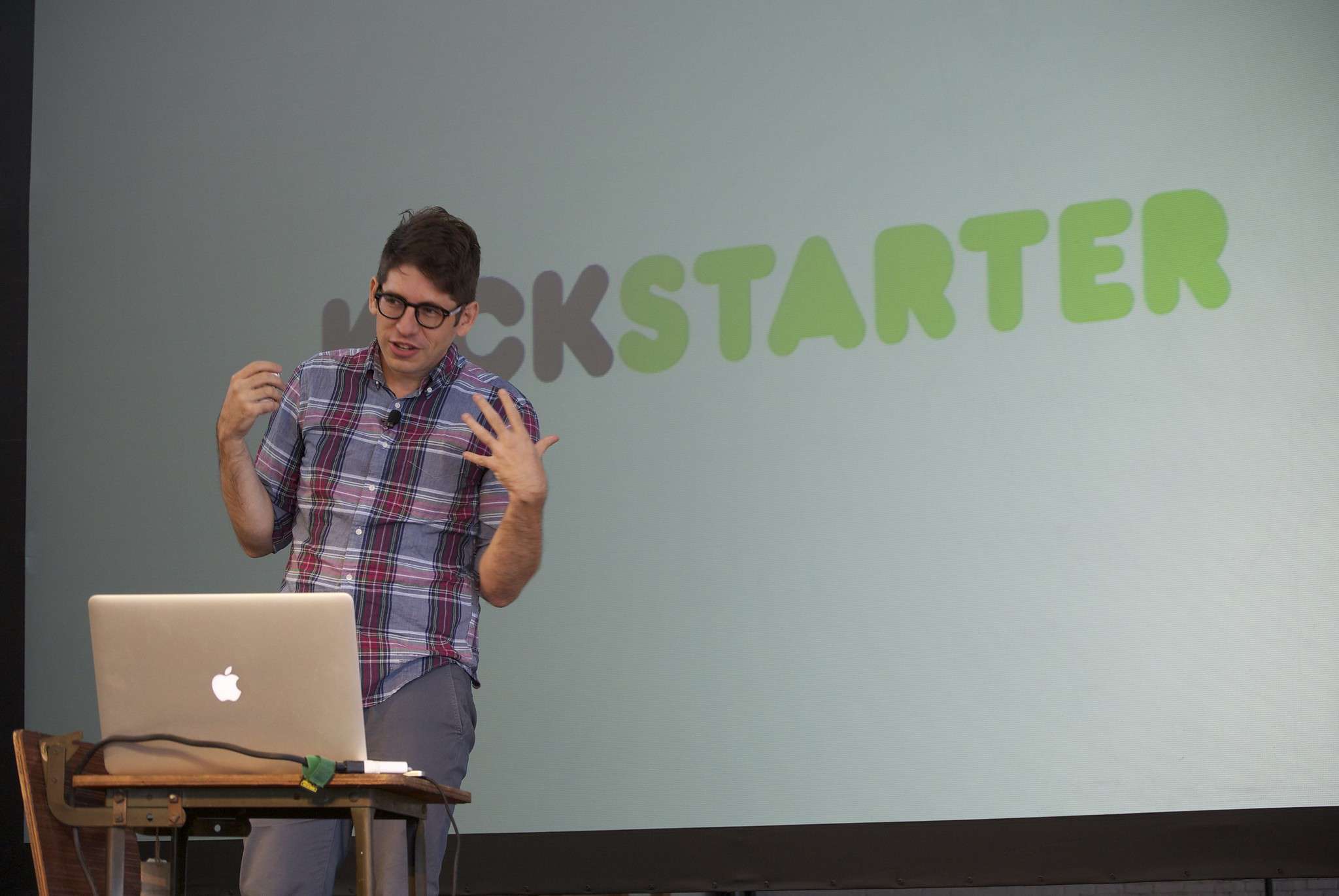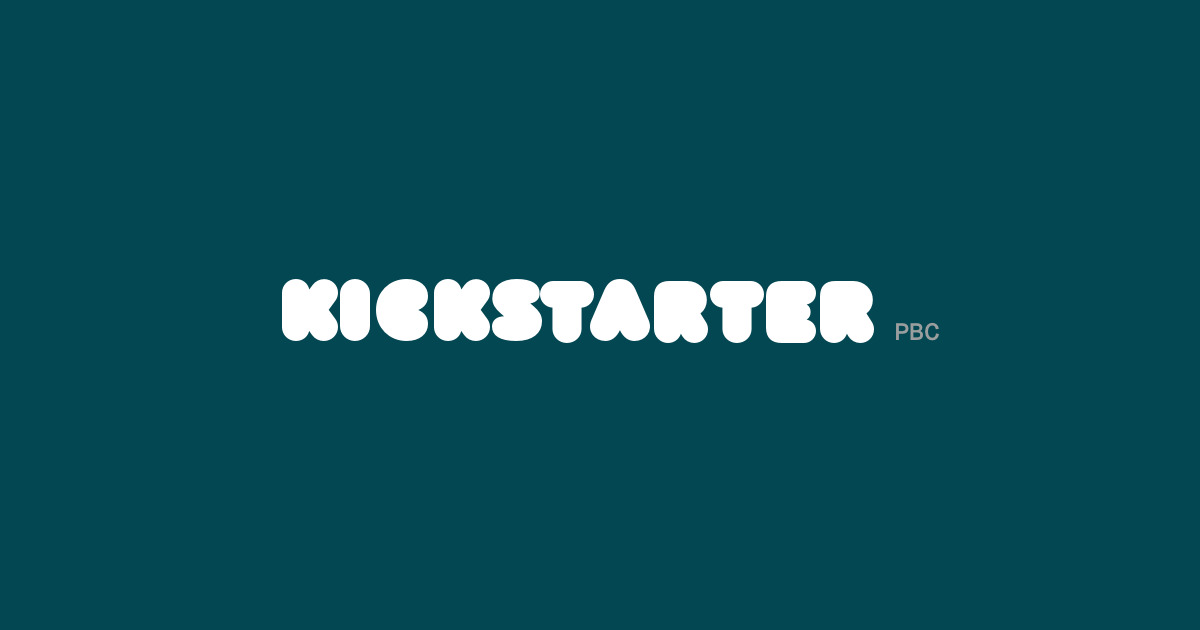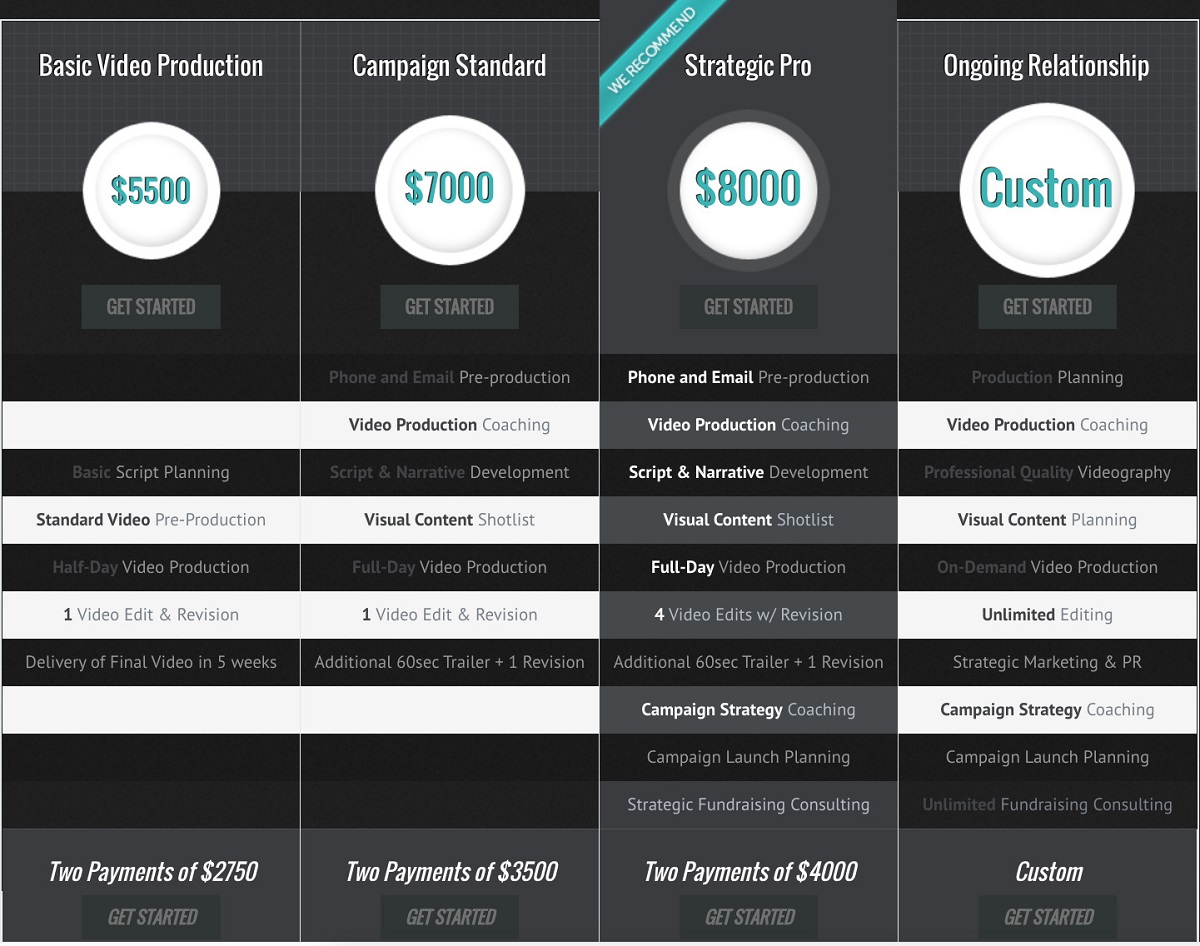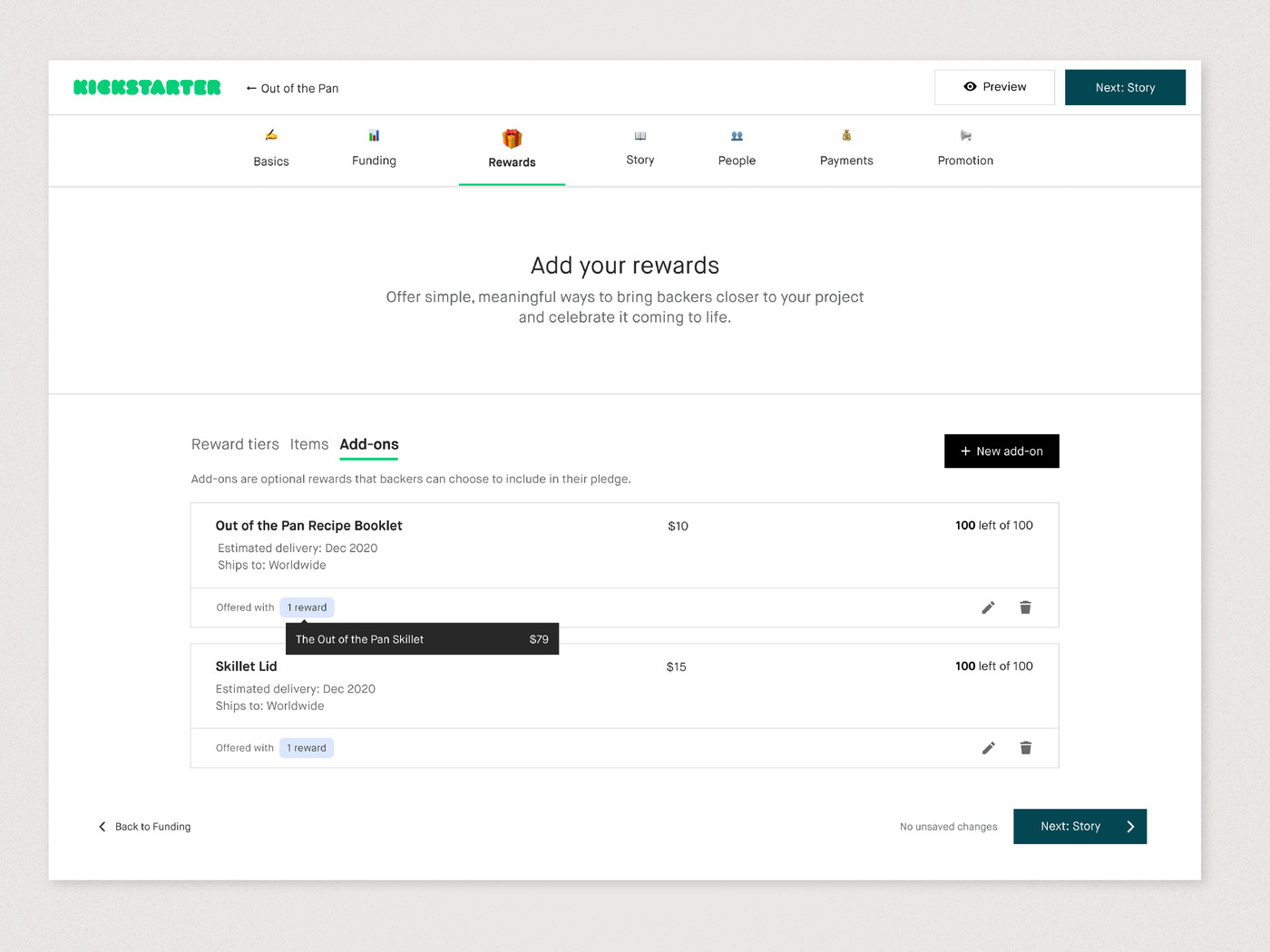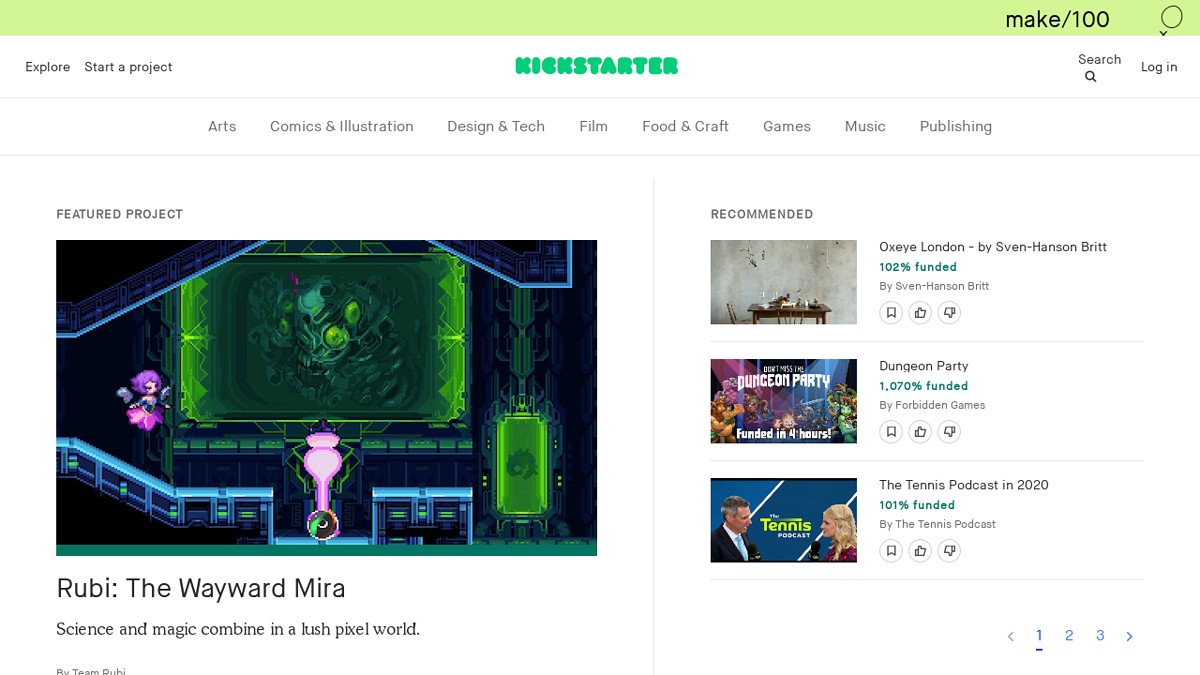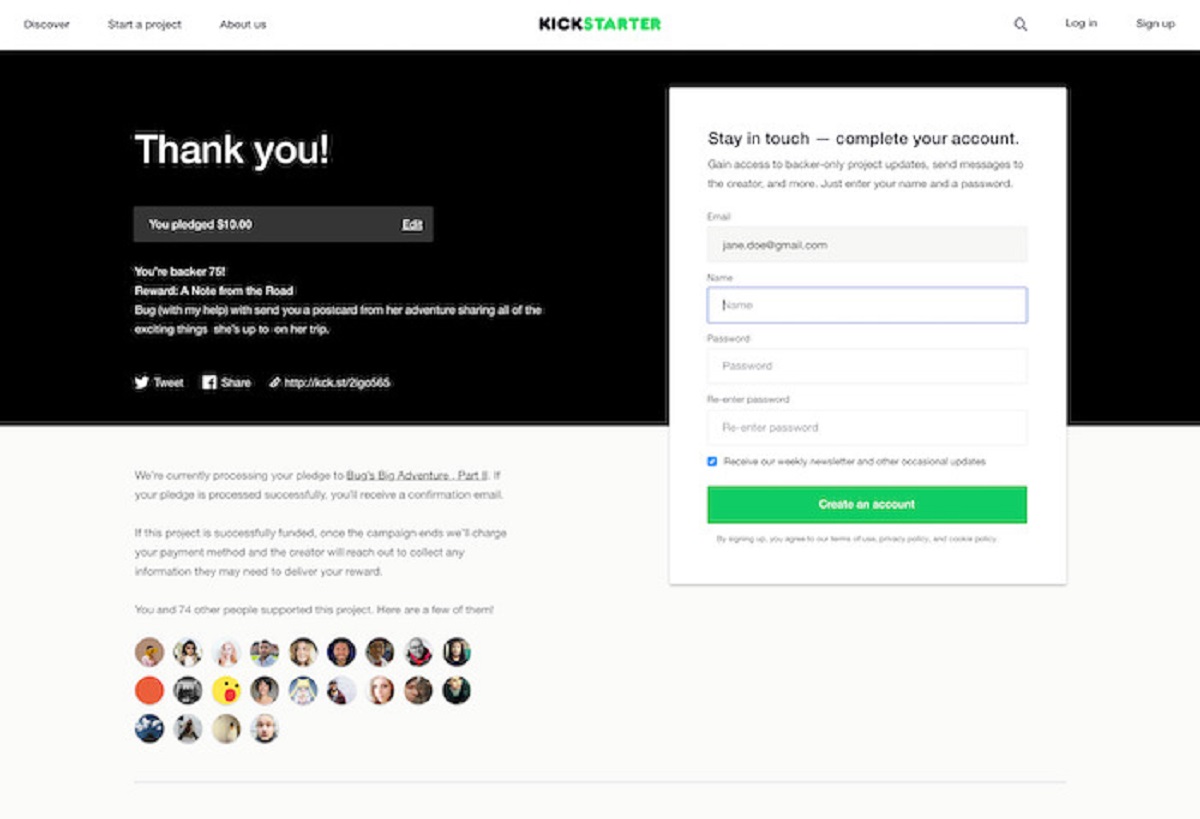Introduction
Welcome to the world of Kickstarter, where dreams become reality and creative projects find support from a global community. Kickstarter is a renowned crowdfunding platform that has revolutionized the way entrepreneurs, artists, and creators bring their ideas to life. With its unique funding model and massive user base, Kickstarter has proven to be a game-changer in the world of entrepreneurship and innovation.
Since its inception in 2009, Kickstarter has facilitated the successful funding of countless projects, spanning various industries and interests. From technology advancements to artistic endeavors, Kickstarter has become a hub for individuals with big ideas and limited financial resources. With the power of the crowd, these creators have been able to secure funding, gain exposure, and turn their dreams into tangible products or experiences.
However, as with any platform, there are questions about ownership and the stakeholders involved. Who owns Kickstarter? How does the ownership structure impact the platform and its users? In this article, we will delve into these questions and explore the various aspects of Kickstarter ownership.
By understanding the ownership landscape, we can gain insights into the motivations and decision-making processes that shape Kickstarter’s direction. Whether you are a creator seeking funding, a backer supporting projects, or simply curious about the inner workings of crowdfunding, exploring the ownership of Kickstarter will provide a deeper understanding of the platform’s dynamics and its impact on the world of innovation.
Understanding Kickstarter
Before delving into the intricacies of ownership, it is essential to have a clear understanding of what Kickstarter entails. Kickstarter is an online crowdfunding platform that allows creators to showcase their projects and seek funding from a large community of backers. It operates on a reward-based system, wherein backers receive rewards or perks in exchange for their financial support.
The platform covers a wide range of categories, including art, technology, music, film, publishing, and more. Creators set funding goals and deadlines for their projects, and backers pledge money to help them reach those goals. If a project reaches its funding goal within the specified timeframe, the pledged funds are collected, and the creator can bring their project to life. If the goal is not met, no funds are collected, and the project does not move forward.
One of the key aspects of Kickstarter is the community-driven nature of the platform. It empowers individuals to support projects that align with their interests and values. Backers have the opportunity to be part of the creative process, connect with creators, and receive exclusive rewards, such as early access to products or limited edition items. Kickstarter fosters a sense of collaboration and enables projects to be funded by a passionate community rather than traditional investors.
This unique approach to funding has allowed Kickstarter to gain popularity and support a diverse range of projects that might not have found support through traditional channels. It provides a platform for creators to showcase their work, test market interest, and gain valuable feedback from potential customers.
Furthermore, Kickstarter acts as more than just a fundraising platform. It serves as a marketing tool, providing creators with exposure and generating excitement for their projects. The concept of crowdfunding itself has become a powerful marketing strategy, and many projects have achieved viral success through the word-of-mouth and media attention generated by their Kickstarter campaigns.
In the next sections, we will explore the roles of creators and backers on Kickstarter, the platform’s business model, and delve deeper into the ownership structure that underpins this crowdfunding powerhouse.
The Purpose of Kickstarter
At its core, Kickstarter exists to help bring creative projects to life. The platform serves as a bridge between creators and backers, providing a space where ideas can thrive and receive the necessary financial support to turn into reality.
One of the main purposes of Kickstarter is to democratize funding. Traditionally, access to funding was limited to a select group of investors or organizations with the financial means to support projects. Kickstarter disrupted this model by giving power to the masses. Anyone with a creative idea, passion, and the ability to articulate their project can seek funding on Kickstarter.
This purpose aligns with the ethos of crowdfunding, which aims to remove barriers to entry and provide opportunities for individuals who may have previously struggled to secure funding through traditional avenues. Kickstarter gives creators the autonomy to bring their ideas to fruition without having to rely solely on venture capitalists, lenders, or other gatekeepers of funding.
Another key purpose of Kickstarter is to foster a sense of community and connection between creators and backers. It enables individuals to support projects and causes they feel a genuine connection to, becoming part of the journey from concept to completion. Kickstarter has created a space where creators can engage directly with their backers, sharing updates, insights, and rewards, thereby forging a sense of camaraderie and shared excitement.
Additionally, Kickstarter serves as a platform for risk-taking and experimentation. It encourages creators to take bold creative leaps and pursue projects that may be deemed too niche or unconventional by mainstream funding institutions. By providing a space for these projects to thrive, Kickstarter has become a breeding ground for innovation, pushing the boundaries of what is considered possible.
Overall, the purpose of Kickstarter is to empower creators, nurture creativity, and provide a platform for projects that may not have had the opportunity to come to life otherwise. It acts as a catalyst for entrepreneurship, artistic expression, and community engagement, fueling the growth and diversity of the creative landscape.
In the following sections, we will explore the roles of creators and backers on Kickstarter, shedding light on their respective contributions to the platform’s success.
The Role of Creators
Creators are the driving force behind every project on Kickstarter. They are the individuals, artists, entrepreneurs, and innovators who bring their ideas to the platform in search of funding and support. The role of creators is crucial in shaping the success and impact of Kickstarter.
First and foremost, creators are responsible for crafting compelling project pitches that capture the imagination and interest of potential backers. This entails clearly articulating their vision, explaining the purpose and goals of their project, and showcasing their expertise and passion. By effectively communicating their ideas, creators can generate enthusiasm and attract the attention of the Kickstarter community.
Creators also play a significant role in setting the funding goals and deadlines for their projects. This involves careful planning and consideration, taking into account the scope of the project, the resources required for execution, and the financial support they hope to receive. Setting realistic and achievable goals is essential to ensure transparency and build trust with potential backers.
Once a project is live on Kickstarter, creators take on the responsibility of actively engaging with the community. This includes providing regular updates, answering questions, and offering insights into the progress and development of their projects. Maintaining open lines of communication helps to build trust, foster engagement, and keep backers informed and invested in the project’s journey.
Creators also have the opportunity to offer rewards to backers as a way of expressing gratitude for their support. Rewards can range from digital downloads and early access to physical products, to personalized experiences or limited edition merchandise. Choosing and delivering rewards is a crucial aspect of the creator’s role, as it allows them to show appreciation and create a sense of exclusivity for backers.
Furthermore, creators contribute to the larger Kickstarter community by sharing their experiences, insights, and lessons learned. They provide valuable knowledge and inspiration to others who may be embarking on their own creative endeavors. This collaborative spirit encourages a sense of growth and learning within the Kickstarter ecosystem.
The role of creators extends beyond the completion of their projects. They are ambassadors for the platform, showcasing the power of Kickstarter as a launchpad for ideas and a community-driven funding source. Successful projects not only benefit the creators personally but also contribute to the overall reputation and allure of Kickstarter as a platform for innovation and creativity.
In the next section, we will explore the role of backers, who play an equally vital part in the success of Kickstarter projects.
The Role of Backers
Backers are the lifeblood of Kickstarter. Without their financial support and belief in the projects they back, Kickstarter would not have achieved its remarkable success. Backers play a vital role in the realization of creative ideas and projects by providing the necessary funds for creators to bring their visions to life.
First and foremost, backers have the power to transform ideas into reality by pledging their financial support to projects that resonate with them. By backing a project, they become an integral part of its success and journey. This financial support enables creators to secure the resources, materials, and expertise required to turn their ideas into tangible products or experiences.
Backers also serve as motivators and sources of encouragement for creators. The act of backing a project not only validates the concept but also instills confidence in the creator that their work has an enthusiastic audience. This support can be a morale booster for creators, pushing them to persevere through challenges and stay focused on delivering their best work.
Additionally, backers play a crucial role in the feedback loop of Kickstarter projects. Through their engagement with creators and the platform, they provide valuable insights, suggestions, and critique that can help shape and refine projects. Backers provide a fresh perspective and diverse viewpoints that can enhance the creative process and improve the final outcome.
As the Kickstarter community continues to grow, backers also act as advocates for projects and creators they believe in. They share their excitement and experiences with friends, family, and social networks, expanding the reach and visibility of projects. This word-of-mouth promotion is essential for driving engagement and attracting new backers to Kickstarter.
Furthermore, backers contribute to the sense of community on Kickstarter. By supporting often niche and innovative projects, they demonstrate a willingness to explore and appreciate creative endeavors outside of mainstream offerings. This creates an environment where unconventional ideas and voices can thrive, fostering a diverse and vibrant creative ecosystem.
Backers also benefit from their involvement in Kickstarter projects. They have the opportunity to receive unique rewards, exclusive experiences, and early access to products before they are available to the general public. These rewards provide backers with a sense of ownership and connection to the projects they support.
Overall, the role of backers on Kickstarter is crucial in enabling the success and impact of projects. Their financial support, enthusiasm, feedback, and promotion contribute to a thriving community where creativity and innovation find a supportive audience.
In the following sections, we will explore the business model of Kickstarter and dive into the ownership structure of this platform that brings creators and backers together.
Kickstarter’s Business Model
In order to sustain its operations and provide a platform for creators and backers, Kickstarter employs a distinct business model. Understanding this business model helps shed light on the financial aspects and incentives that drive the platform’s functionality.
At its core, Kickstarter operates on a commission-based revenue model. The platform charges a fee on successfully funded projects, taking a percentage of the total funds raised. This fee covers the costs associated with running and maintaining the platform, as well as supporting ongoing development and improvements.
Kickstarter’s current fee structure is as follows: for projects successfully funded, Kickstarter charges a 5% fee on the total funds raised. In addition to this, there are payment processing fees, typically around 3-5%, which are deducted by the financial service providers that enable the payment transactions.
This revenue model allows Kickstarter to align its success with the success of the projects on its platform. By taking a percentage of successfully funded projects, Kickstarter has a vested interest in facilitating the funding of high-quality, appealing projects. This ensures that the platform remains a trusted marketplace and maintains a high standard for project selection.
It is important to note that Kickstarter operates on an all-or-nothing funding model. If a project does not reach its funding goal within the specified timeframe, no funds are collected, and backers are not charged. This model mitigates the risk for both creators and backers by ensuring that projects have a sufficiently secure financial foundation before proceeding.
In addition to the commission-based revenue model, Kickstarter also benefits from the network effect and the inherent virality of successful projects. As projects gain traction and generate attention, the platform gains increased visibility and attracts new creators and backers. The success of one project can lead to the success of others, creating a positive cycle of growth for the platform.
Kickstarter also collaborates with various partners to enhance the platform and provide additional opportunities for creators and backers. These partnerships may include collaborations with organizations, companies, or institutions that align with Kickstarter’s mission and values. Through these partnerships, Kickstarter offers creators access to additional resources and expertise, further supporting their projects.
Overall, Kickstarter’s business model revolves around providing a platform for creators to showcase their projects, connecting them with backers who can support their vision financially. The commission-based revenue model, coupled with the network effect and strategic partnerships, sustains the platform’s operations and encourages the growth of a vibrant creative community.
In the following sections, we will delve into the ownership structure of Kickstarter and explore the stakeholders that play a role in shaping the platform’s direction.
Ownership of Kickstarter
When examining the ownership of Kickstarter, it is essential to consider the various stakeholders involved in shaping the platform’s direction. Kickstarter is a private company that was founded by Perry Chen, Yancey Strickler, and Charles Adler in 2009. Initially, the founders held ownership stakes in the company.
As Kickstarter grew in popularity and attracted more attention, its ownership expanded beyond its founders. Early investors who believed in the potential of the platform also acquired ownership stakes. These early investors played a crucial role in providing the necessary funding and support to help Kickstarter scale and develop its infrastructure.
Over the years, Kickstarter’s ownership structure has evolved. While the original founders, Perry Chen, Yancey Strickler, and Charles Adler, made significant contributions during the platform’s early days, they have since transitioned into other roles or moved on to new ventures. However, their initial contributions and vision laid the foundation for Kickstarter’s success.
As Kickstarter has grown, it has brought in new leadership and board members who have a vested interest in the platform’s success. These board members provide guidance and strategic direction, shaping the decisions and policies that govern Kickstarter’s operations. The board’s involvement ensures that the platform remains aligned with its original mission while adapting to the evolving landscape of crowdfunding and creative projects.
It is important to note that as a private company, Kickstarter’s ownership is not publicly traded on the stock market. This means that ownership shares are not available for public purchase and are primarily held by the founders, early investors, and board members.
Additionally, while the ownership structure influences the decision-making processes and long-term goals of Kickstarter, it is crucial to highlight that the platform is ultimately driven by its community. The creators and backers who use Kickstarter contribute to its success and influence the types of projects that thrive on the platform.
Kickstarter’s ownership structure, combined with the active engagement of its community, allows the platform to retain its unique character and focus on supporting creative ventures. The ownership stakeholders bring expertise, resources, and experience to the table, ensuring that Kickstarter continues to be a trusted and influential force in the crowdfunding landscape.
In the subsequent sections, we will explore the implications of ownership and the influence it has on Kickstarter’s operations and the projects it supports.
Ownership Stakeholders
When examining the ownership of Kickstarter, it’s important to identify the various stakeholders who hold ownership stakes and have a vested interest in the platform’s success. These ownership stakeholders include the founders, early investors, board members, and the Kickstarter community itself.
The founders, Perry Chen, Yancey Strickler, and Charles Adler, initially held ownership stakes in Kickstarter. They were responsible for establishing the platform, shaping its mission, and setting it on its path to success. Although they may have transitioned from their roles as day-to-day operators, their contributions were instrumental in Kickstarter’s early growth.
Early investors also hold ownership stakes in Kickstarter. These investors recognized the potential of the platform and provided the necessary funding to fuel its growth. Their support and monetary contributions helped Kickstarter scale and develop the infrastructure needed to serve its expanding community of creators and backers.
The board members of Kickstarter play a significant role in shaping the platform’s direction and policies. These individuals bring expertise, industry knowledge, and strategic guidance to the table. They actively participate in decision-making processes, providing guidance to ensure that Kickstarter remains true to its core mission while adapting to the ever-changing crowdfunding landscape.
While the founders, early investors, and board members contribute to the ownership landscape, it’s important to note that the Kickstarter community itself holds a form of ownership. The collective power of the community, comprised of creators and backers, shapes the projects and initiatives that thrive on the platform. Backers, in particular, have the ability to support projects and directly impact their success.
By supporting projects through financial backing, backers become invested in the success of those projects. This creates a sense of ownership and involvement in the outcomes. Backers have the opportunity to engage directly with creators, offer feedback, and contribute to the development of projects through their financial support.
The collective ownership held by the Kickstarter community is a unique aspect of the platform. It allows for a democratic and collaborative approach to funding creative projects. Rather than a traditional ownership model where a select few hold significant power, Kickstarter empowers a diverse community to shape the platform’s ecosystem.
Overall, the ownership stakeholders in Kickstarter range from the original founders and early investors to the current board members and the active community of creators and backers. Each stakeholder brings valuable contributions and influences the platform’s growth and direction. This multi-faceted ownership landscape ensures that Kickstarter remains a dynamic and community-driven platform for crowdfunding creative endeavors.
In the next section, we will explore the current ownership structure of Kickstarter and the implications it has on the platform’s operations and vision.
Early Investors and Board Members
Early investors and board members have played a significant role in shaping Kickstarter’s trajectory and success. These stakeholders have contributed financial resources, expertise, and guidance to support the platform’s growth and development.
Early investors have played a crucial part in Kickstarter’s journey by recognizing its potential early on and providing the necessary funding to fuel its expansion. Their financial contributions helped Kickstarter scale its operations, enhance its technological infrastructure, and expand its user base. With their investments, early investors demonstrated their belief in the platform and its ability to disrupt traditional funding channels.
In addition to financial support, early investors often bring their industry insights and experience to the table. Their knowledge and expertise can benefit Kickstarter by providing guidance on strategic decisions, market trends, and best practices. Their involvement can help shape the platform’s direction and ensure that it stays responsive to emerging trends in crowdfunding and creative projects.
Board members play a pivotal role in providing oversight and strategic guidance to Kickstarter. They typically have a wealth of experience in various industries and bring diverse perspectives to the table. The board helps steer the platform’s long-term vision, shape its policies, and ensure that it remains aligned with its mission of supporting creative endeavors.
Board members collaborate with Kickstarter’s executive team, working closely with the platform’s leadership to make informed decisions about the direction of the company. They contribute their expertise and network to further Kickstarter’s growth and strengthen its position in the crowdfunding space.
Furthermore, board members are responsible for representing the best interests of the various stakeholders involved in Kickstarter, including the creators, backers, and the broader community. They work to strike a balance between maintaining the platform’s integrity and promoting its growth, ensuring that the entrepreneurial spirit and creative innovation are preserved.
The early investors and board members collectively form a crucial support system for Kickstarter. Their involvement ensures that the platform has the necessary resources, guidance, and expertise to sustain its operations, adapt to changing market conditions, and remain at the forefront of crowdfunding innovation.
While the ownership structure of Kickstarter includes these key stakeholders, it is important to note that the Kickstarter community also plays an essential role in shaping the platform. The collective efforts of creators and backers contribute to Kickstarter’s success and influence the types of projects that are showcased on the platform.
In the subsequent section, we will delve into the current ownership structure of Kickstarter and explore its implications for the platform and its stakeholders.
Current Ownership Structure
The current ownership structure of Kickstarter encompasses various stakeholders who have a vested interest in the success and direction of the platform. While specifics of ownership percentages and individuals involved may not be publicly disclosed, it is known that the ownership has evolved over time.
Initially, the ownership stakes in Kickstarter were held by the founders, Perry Chen, Yancey Strickler, and Charles Adler. As the platform grew, early investors also acquired ownership stakes, providing the necessary funding to support Kickstarter’s expansion and development.
However, as the platform matured, the ownership landscape has likely undergone changes. Founders may have transitioned from their operational roles, while retaining ownership as stakeholders. At the same time, early investors may have reduced or maintained their ownership stakes in line with the growth and success of Kickstarter.
In addition to the founders and early investors, board members also hold ownership stakes in Kickstarter. These board members bring expertise, guidance, and industry insights to the platform. The board’s involvement ensures that Kickstarter’s operations and strategies are in line with its mission and values.
While the specific details of the ownership structure may not be publicly available, what remains clear is that the ownership of Kickstarter encompasses a combination of founders, early investors, and board members. Together, these stakeholders contribute to the decisions and direction of the platform.
It is important to note that Kickstarter’s ownership structure is not publicly traded on the stock market like a publicly held company. Kickstarter operates as a private company, granting ownership rights and decision-making powers to the individuals involved in its ownership structure.
As a private company, Kickstarter’s ownership structure allows for flexibility and agility in decision-making processes. This allows the platform to remain focused on its mission and respond to the needs and interests of its community of creators and backers.
The ownership structure of Kickstarter, with its combination of founders, early investors, and board members, ensures that the platform has the necessary resources, expertise, and guidance to navigate the dynamic landscape of crowdfunding and continue to provide a robust platform for creative projects.
In the subsequent section, we will explore the implications of the ownership structure and how it affects the operation and direction of Kickstarter.
Implications of Ownership
The ownership structure of Kickstarter has several implications that shape the platform’s operations and impact its stakeholders. Understanding these implications provides insights into how decisions are made, the platform’s alignment with its mission, and the relationship between ownership and the Kickstarter community.
Firstly, the ownership structure influences the decision-making processes of Kickstarter. Founders, early investors, and board members, who hold ownership stakes, have a say in strategic decisions and the platform’s long-term direction. Their expertise and perspectives guide the platform’s growth, ensuring that it remains focused on supporting creative projects and fostering a vibrant community.
Ownership also plays a role in the financial sustainability of the platform. The ownership stakeholders, including early investors, benefit from the success and growth of Kickstarter. Their financial outcomes are tied to the platform’s performance, incentivizing them to support initiatives that enhance the platform and its services.
Furthermore, ownership can impact the platform’s relationship with its community of creators and backers. The decisions made by the ownership stakeholders shape the policies, fee structures, and terms of engagement on Kickstarter. Balancing the interests of the ownership stakeholders with the needs and aspirations of the community ensures a platform that is fair, transparent, and responsive to its users.
The ownership structure also affects Kickstarter’s ability to attract and retain talent. As a private company, the ownership stakeholders play a crucial role in shaping the platform’s culture, values, and operations. This can impact the platform’s ability to recruit and retain individuals who align with its vision and bring the necessary skill sets to drive innovation and growth.
Additionally, the ownership structure can influence the perception of Kickstarter and its community. The involvement of notable board members and early investors can enhance the platform’s reputation and attract interest from creators, backers, and the wider public. Strong ownership, coupled with a passionate community, solidifies Kickstarter’s position as a trusted and influential force in the crowdfunding ecosystem.
Overall, the ownership structure of Kickstarter has far-reaching implications for the platform’s decision-making, financial sustainability, relationship with its community, talent acquisition, and overall reputation. The alignment of ownership stakeholders with the platform’s mission, values, and community is essential to ensure the continued success and impact of Kickstarter as a leading crowdfunding platform.
In the final section, we will summarize the key points discussed and provide a holistic view of the ownership and impact of Kickstarter.
Conclusion
Kickstarter, as a crowdfunding platform, has revolutionized the way creative projects are funded and brought to life. The ownership structure of Kickstarter, comprised of founders, early investors, board members, and the active community of creators and backers, plays a crucial role in shaping the platform’s operations and impact.
From its humble beginnings as a concept by Perry Chen, Yancey Strickler, and Charles Adler, Kickstarter has evolved into a platform that empowers creators and connects them with a passionate community of backers. The early investors who recognized its potential provided the necessary funding to fuel the platform’s growth and development.
The board members, with their guidance and expertise, steer the platform’s long-term vision and ensure alignment with Kickstarter’s mission of supporting creative endeavors. They contribute to strategic decision-making and policies that maintain the platform’s integrity and promote its growth.
While the ownership stakeholders hold a significant role in Kickstarter, the community itself is an integral part of the ownership landscape. Creators and backers contribute to the success and direction of Kickstarter by actively supporting projects, providing feedback, and fostering a sense of community and collaboration.
The ownership structure of Kickstarter influences important factors such as decision-making processes, financial sustainability, relationship with the community, talent acquisition, and platform perception. The platform’s owners have a vested interest in its success and play a crucial role in shaping policies that benefit both creators and backers.
Ultimately, Kickstarter’s ownership structure ensures that the platform remains a dynamic and thriving ecosystem for crowdfunding creative projects. It combines the expertise and financial resources of stakeholders with the passion and creativity of the community, creating an environment where innovation can flourish.
As Kickstarter continues to evolve, its ownership structure will inevitably evolve as well. New investors may become part of the ownership stakeholders, bringing fresh perspectives and resources to further enhance the platform’s impact.
Overall, the ownership of Kickstarter is a collaborative effort that supports the platform’s mission of empowering creators and fostering a vibrant creative community. It is the collective actions and contributions of the ownership stakeholders and the Kickstarter community that make the platform a driving force in the world of crowdfunding and creative innovation.









